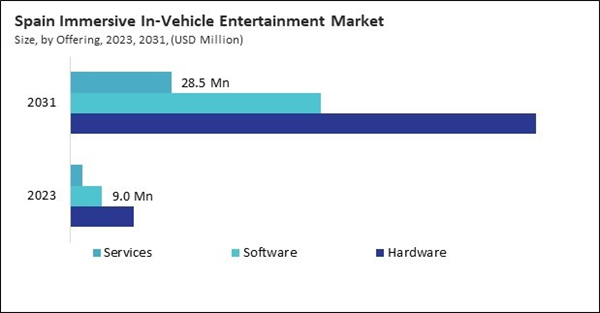The Europe Immersive In-Vehicle Entertainment Market is expected to witness market growth of 26.9% CAGR during the forecast period (2024-2031).
The Germany market dominated the Europe Immersive In-Vehicle Entertainment Market by Country in 2023, and is expected to continue to be a dominant market till 2031; thereby, achieving a market value of $803.1 million by 2031. The UK market is exhibiting a CAGR of 25.8% during 2024-2031. Additionally, the France market would experience a CAGR of 27.9% during 2024-2031.
The rise of electric and autonomous vehicles has also played a crucial role in this adoption. As vehicles become more automated, the traditional role of the driver is changing. Passengers are now looking for ways to occupy their time during journeys, making in-vehicle entertainment a priority for manufacturers. The increasing prevalence of connected vehicles equipped with high-speed internet and advanced infotainment systems has further facilitated the adoption of these technologies.
Moreover, the COVID-19 pandemic has accelerated the demand for in-vehicle entertainment solutions. With more individuals relying on personal vehicles for transportation due to health concerns, the focus on creating enjoyable and engaging travel experiences has intensified. Consumers are increasingly investing in vehicles with advanced entertainment features, further driving market growth.
The immersive in-vehicle entertainment market in Germany is experiencing significant growth, driven by the country’s status as an automotive powerhouse. In 2021, German automobile manufacturers produced over 15.6 million vehicles, creating a vast and diverse platform for integrating advanced entertainment systems. As automakers increasingly focus on enhancing the in-vehicle experience, the demand for innovative infotainment solutions has surged. Technologies such as augmented reality (AR) and virtual reality (VR) are becoming essential, offering passengers interactive and immersive experiences during their journeys. This shift enhances passenger satisfaction and positions German automakers at the forefront of a rapidly evolving entertainment landscape.
The Germany market dominated the Europe Immersive In-Vehicle Entertainment Market by Country in 2023, and is expected to continue to be a dominant market till 2031; thereby, achieving a market value of $803.1 million by 2031. The UK market is exhibiting a CAGR of 25.8% during 2024-2031. Additionally, the France market would experience a CAGR of 27.9% during 2024-2031.
The rise of electric and autonomous vehicles has also played a crucial role in this adoption. As vehicles become more automated, the traditional role of the driver is changing. Passengers are now looking for ways to occupy their time during journeys, making in-vehicle entertainment a priority for manufacturers. The increasing prevalence of connected vehicles equipped with high-speed internet and advanced infotainment systems has further facilitated the adoption of these technologies.
Moreover, the COVID-19 pandemic has accelerated the demand for in-vehicle entertainment solutions. With more individuals relying on personal vehicles for transportation due to health concerns, the focus on creating enjoyable and engaging travel experiences has intensified. Consumers are increasingly investing in vehicles with advanced entertainment features, further driving market growth.
The immersive in-vehicle entertainment market in Germany is experiencing significant growth, driven by the country’s status as an automotive powerhouse. In 2021, German automobile manufacturers produced over 15.6 million vehicles, creating a vast and diverse platform for integrating advanced entertainment systems. As automakers increasingly focus on enhancing the in-vehicle experience, the demand for innovative infotainment solutions has surged. Technologies such as augmented reality (AR) and virtual reality (VR) are becoming essential, offering passengers interactive and immersive experiences during their journeys. This shift enhances passenger satisfaction and positions German automakers at the forefront of a rapidly evolving entertainment landscape.
List of Key Companies Profiled
- Tesla, Inc.
- Sony Corporation
- Panasonic Holdings Corporation
- Continental AG
- Harman International Industries, Inc. (Samsung Electronics Co., Ltd.)
- Robert Bosch GmbH
- LG Electronics, Inc. (LG Corporation)
- Qualcomm Incorporated (Qualcomm Technologies, Inc.)
- Apple Inc.
- Google LLC
Market Report Segmentation
By Vehicle Type
- Passenger Vehicles
- Commercial Vehicles
By Offering
- Hardware
- Software
- Services
By Device Type
- Head-Mounted Displays (HMDs)
- In-Car Displays
- Wearables
- Other Device Type
By Application
- Infotainment
- Navigation Assistance
- Safety & Driver Assistance
- Passenger Entertainment & Others
By Technology
- Augmented Reality (AR)
- Virtual Reality (VR)
- Mixed Reality (MR)
- 360-Degree Video
- Other Technology
By Distribution Channel
- OEM
- Aftermarket
By Country
- Germany
- UK
- France
- Russia
- Spain
- Italy
- Rest of Europe
Table of Contents
Chapter 1. Market Scope & Methodology
Chapter 2. Market at a Glance
Chapter 3. Market Overview
Chapter 4. Competition Analysis - Global
Chapter 5. Europe Immersive In-Vehicle Entertainment Market by Vehicle Type
Chapter 6. Europe Immersive In-Vehicle Entertainment Market by Offering
Chapter 7. Europe Immersive In-Vehicle Entertainment Market by Device Type
Chapter 8. Europe Immersive In-Vehicle Entertainment Market by Application
Chapter 9. Europe Immersive In-Vehicle Entertainment Market by Technology
Chapter 10. Europe Immersive In-Vehicle Entertainment Market by Distribution Channel
Chapter 11. Europe Immersive In-Vehicle Entertainment Market by Country
Chapter 12. Company Profiles
Companies Mentioned
- Tesla, Inc.
- Sony Corporation
- Panasonic Holdings Corporation
- Continental AG
- Harman International Industries, Inc. (Samsung Electronics Co., Ltd.)
- Robert Bosch GmbH
- LG Electronics, Inc. (LG Corporation)
- Qualcomm Incorporated (Qualcomm Technologies, Inc.)
- Apple Inc.
- Google LLC
Methodology

LOADING...









